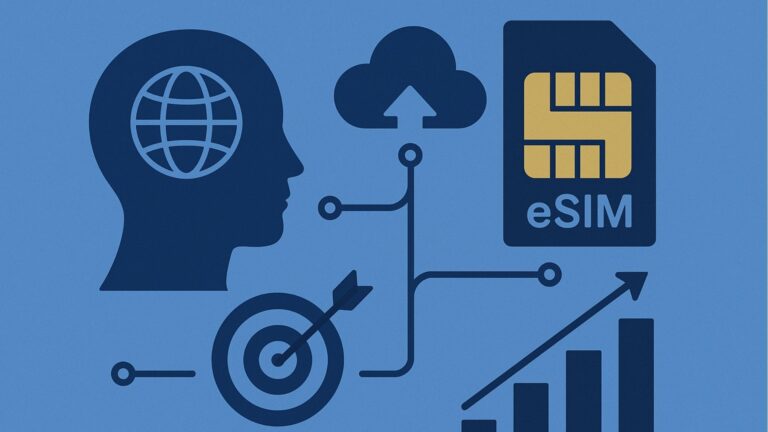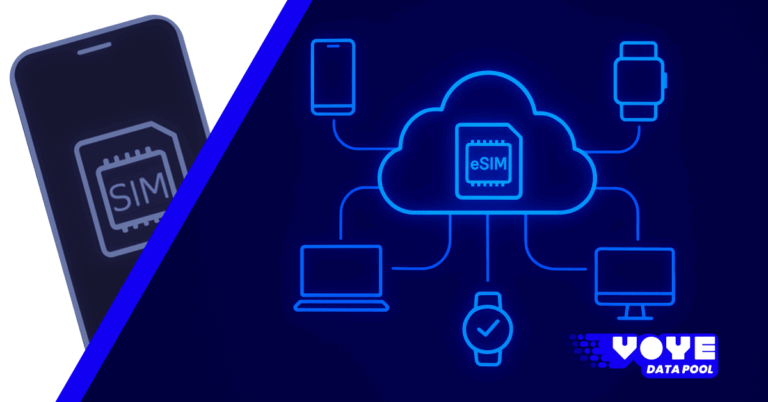Future of Global Work: Connectivity as the Backbone of Distributed Enterprises
The future of global work is being redefined by the power of connectivity. From remote teams to cloud-based operations, digital collaboration is now the backbone of success. Enterprises across the world are evolving into distributed ecosystems powered by reliable communication and smart networks.

Distributed work is no longer an experiment. It is an operating model that stretches across regions, partners, and time zones. The single factor that quietly determines whether this model performs or struggles is connectivity. When mobile data is reliable, secure, and centrally governed, distributed enterprises move faster, serve customers better, and control costs. When connectivity is fragmented, teams lose time to friction, shadow IT proliferates, and security risks multiply.
This article explains how to treat connectivity as core infrastructure rather than a travel expense. It presents a practical operating model and adoption roadmap for enterprise leaders. Throughout, it shows how Voye Data Pool delivers the foundation: Enterprise eSIM Connectivity, Simplified. Instantly activate, manage, and monitor eSIMs for your staff in 130+ countries, from one secure platform.
Enterprise Mobility: Equip employees with secure, centrally managed mobile access across the globe.
Remote Teams & Travel: Eliminate roaming charges and simplify connectivity for distributed workforces.
The New Enterprise Perimeter Is Everywhere
Modern organizations now span:
- Distributed HQs and satellite offices: Regional hubs with unique carrier footprints.
- Remote-first and hybrid teams: Knowledge workers who collaborate across locations and travel frequently.
- Mobile frontline and field teams: Sales, service, operations, and logistics personnel who depend on real-time access.
- Contractors and partners: Temporary access requirements that must still meet corporate standards.
In this world, “the network” is no longer a single building or a VPN entry point. Connectivity must follow users wherever they go, across cities and countries, with consistent policy, performance, and security. The perimeter is people-centric, device-centric, and data-centric.
Implication for leaders: Treat connectivity as a standard, governed capability that scales globally, not as a fragmented local procurement problem.
Connectivity Maturity: From Ad Hoc to Strategic
Enterprises typically move through four stages:
- Ad Hoc: Employees fend for themselves with personal SIMs, hotel Wi-Fi, and expense claims. Data quality is inconsistent, controls are weak, and finance cannot forecast costs.
- Tactical: IT issues travel SIMs per trip. Logistics become complex. Cards are lost, pooled, or outdated. Visibility remains low and billing is unpredictable.
- Coordinated: A small set of global roaming contracts exists. There is some predictability, but contracts are inflexible, rates vary by region, and provisioning is slow.
- Strategic eSIM Orchestration: Connectivity is software-defined and centrally governed. IT can instantly activate, pause, or reassign plans, automate policy, and track usage and cost in real time. Finance can predict and optimize. Security and compliance are built in.
Goal: Advance to Stage 4 with an enterprise eSIM platform that consolidates policy, cost control, and observability. This is where Voye Data Pool operates.
Why eSIM-Centric Connectivity Wins for Distributed Work
Instant, Contactless Activation
Physical logistics are removed. Employees or contractors can be onboarded with a QR code or MDM push, which means connectivity is ready on day one.
Centralized Policy and Cost Control
Plans can be right-sized by cohort, location, or project, then adjusted in real time. Finance gets a clear, consolidated view and can enforce budgets at the policy level.
Security by Design
Compared to unmanaged public Wi-Fi, centrally governed mobile data provides stronger confidentiality and integrity. You can apply conditional access, device posture checks, and zero-trust policies with more consistent results.
Business Continuity and CX
Sales demos, field repairs, telemedicine consults, and airport reroutes all depend on uninterrupted data. eSIM orchestration reduces the chance of downtime at precisely the moments that matter.
Sustainability and Operations
No plastic cards to ship. No waste from unused inventories. Less administrative overhead. Faster recovery when devices are replaced.
Voye Data Pool combines these advantages with a single control plane to activate, manage, and monitor eSIMs across 130+ countries, giving IT and finance the levers they need without slowing down the business.
An Operating Model for Connectivity as Core Infrastructure
To make connectivity dependable and governable, align on five pillars.
Pillar 1: Architecture and Governance
- Single Control Plane: Use one platform to provision eSIMs, allocate data, and apply policy across regions.
- Role-Based Access: IT admins, regional managers, finance controllers, and security teams get scoped actions and reporting.
- Policy as Code: Express data caps, roaming rules, device posture, and exception workflows declaratively for consistency.
Pillar 2: Identity and Device Management
- Directory-Driven Assignment: Tie eSIM entitlements to HRIS or IAM, so onboarding and offboarding are automatic.
- Device Posture Enforcement: Require OS updates, encryption, and lock-screen policies before granting data.
- Lifecycle Automation: Reclaim plans on role changes or offboarding to eliminate orphaned costs.
Pillar 3: Security and Compliance
- Private Access to Corporate Apps: Prefer managed mobile data to public Wi-Fi to reduce interception risk.
- Data Residency Awareness: Respect local regulations by controlling where plans are issued and used.
- Auditable Trails: Maintain logs for provisioning, usage, and policy changes to satisfy internal and external audits.
Pillar 4: Cost Intelligence
- Real-Time Usage Visibility: See spend, burn rate, and forecast by team, project, and geography.
- Policy-Driven Optimization: Automatically throttle, alert, or reallocate data when thresholds are reached.
- Unit Economics: Attribute costs to business outcomes (revenue, tickets resolved, customer meetings) to validate ROI.
Pillar 5: Employee Experience
- Frictionless Activation: A QR code or MDM push that just works.
- Self-Service: Empower employees to view balance, request top-ups, and see policy in plain language.
- Rapid Support: Centrally managed troubleshooting and the ability to swap devices without waiting.
How Voye Data Pool helps: A unified administration console, policy automation, real-time analytics, and a global carrier fabric make these pillars practical on day one.

Seamless eSIM Connectivity for Enterprises
Activate, manage, and scale eSIMs with ease.
Governance Patterns for Different Workforces
A) Remote Knowledge Workers
- Policy Focus: Always-on secure data for collaboration tools and voice.
- Controls: Monthly caps with smart alerts; whitelisting of corporate app domains if needed.
- Outcome: Predictable costs and fewer incidents from risky Wi-Fi.
B) Frequent Travelers and Executives
- Policy Focus: High-availability plans with regional or global coverage.
- Controls: Priority support, automated top-ups, and travel-triggered policy changes.
- Outcome: Zero friction in airports, hotels, and cross-border moves.
C) Frontline and Field Teams
- Policy Focus: Reliable field data for route planning, job orders, diagnostics, and proof-of-service.
- Controls: Device posture enforced, data budget linked to job type or territory.
- Outcome: Higher first-time fix rates and fewer delays.
D) Contractors and Seasonal Staff
- Policy Focus: Time-bound entitlements and least-privilege access.
- Controls: Auto-expiring plans that deactivate upon project completion.
- Outcome: Tight control and simpler vendor management.
Voye Data Pool accommodates all four patterns with role-based provisioning, bulk assignments, and automated expirations.
Security and Risk Management
Replace Risky Wi-Fi with Managed Mobile Data
Public Wi-Fi exposes users to spoofing, forced captive portals, and weak encryption. Centrally managed mobile data reduces these risks and allows consistent policy enforcement.
Zero-Trust Integration
Tie data access to user identity, device health, and context. If a device falls out of compliance, automatically restrict or suspend the eSIM plan and notify the user.
Compliance and Auditability
Maintain records of who provisioned which plan, where it was used, and under what policy. This strengthens internal controls and simplifies external audits.
Voye Data Pool supports identity-driven policies and detailed activity logging, providing a defensible security posture.
The Finance Perspective: From OPEX to Strategic Lever
Budget Predictability
Move from unpredictable roaming bills to policy-based spend. Set per-user caps, cohort budgets, and automatic alerts.
Cost Allocation and Forecasting
Attribute connectivity to departments, projects, and clients. Forecast spend using trends and seasonality. Adjust policies with facts, not assumptions.
Hard and Soft ROI
- Hard Savings: Lower per-GB costs, fewer roaming surcharges, reclaimed plans after offboarding.
- Soft Gains: Faster deal cycles, higher field productivity, and reduced downtime.
Voye Data Pool gives finance a single source of truth to control, anticipate, and communicate the value of connectivity.
Key KPIs for Enterprise Connectivity
Track outcomes, not just megabytes:
- Time to Provision: Median minutes from request to live service.
- Activation Success Rate: Percentage of first-attempt activations.
- Usage Predictability: Variance between forecast and actual monthly spend.
- Policy Compliance Rate: Devices meeting posture rules and data policy.
- Field Productivity: Jobs completed per day or time to resolution.
- Employee Experience: Helpdesk tickets per 100 users related to connectivity.
Integration with the Enterprise Stack
Identity and HRIS
- Connect provisioning to HR events. New hires receive eSIM activation automatically. Offboarding triggers deactivation and reclamation.
MDM and Endpoint Security
- Push eSIMs through your existing device management, enforce posture, and verify compliance before data access.
ITSM and Automation
- Trigger eSIM workflows from service catalogs or incident rules. Close the loop with audit logs.
Finance and Analytics
- Export cost and usage data to BI tools. Build dashboards for executives with real-time visibility.
Voye Data Pool is designed to be the connective tissue among these systems, so connectivity becomes a governed, automated workflow rather than a manual chore.
Implementation Roadmap: 90 Days to Value
Phase 1: Assessment and Policy Design (Weeks 1–3)
- Map user cohorts, travel patterns, and current spend.
- Define security and compliance requirements.
- Design policies for each cohort with budget thresholds, activation rules, and exceptions.
Phase 2: Pilot and Integration (Weeks 4–7)
- Run a controlled pilot across 2–3 cohorts and at least two regions.
- Integrate with IAM, MDM, and ticketing.
- Validate KPIs: time to provision, activation success, and spend predictability.
Phase 3: Scale and Governance (Weeks 8–12)
- Roll out to remaining cohorts in batches.
- Turn on usage alerts, exception workflows, and self-service.
- Report early ROI to leadership and refine policies.
Where Voye Data Pool fits: The platform compresses these timelines with instant activation, policy templates, and out-of-the-box analytics.
Practical Playbooks
Onboarding a New Remote Employee
- HR creates the user in the HRIS.
- IAM assigns the user to the “Remote Knowledge Worker” group.
- Voye Data Pool auto-provisions an eSIM plan based on group policy.
- Employee receives a QR code or MDM push and activates in minutes.
- Finance sees the new seat and projected monthly cost immediately.
Supporting an International Trip
- Employee submits travel dates or travel is detected via itinerary integration.
- Policy adjusts to a travel profile for the destination.
- Plan activates on arrival. Alerts keep usage within budget.
- Upon return, policy reverts to the standard profile.
Temporary Access for Contractors
- Project owner requests a time-bound plan tied to a contractor identity.
- Plan auto-expires and is reclaimed at project end.
- Finance allocates the cost to the project code.
Risk Scenarios and Mitigations
- Device Loss: Instantly suspend the plan and reissue to a replacement device.
- Usage Spikes: Alert, throttle, or top-up based on policy.
- Shadow SIMs: Central policy and cost visibility reduce noncompliant purchases.
- Audit Finding: Produce logs and policy records from the Voye Data Pool console.
- Regulatory Change: Update policy templates and reapply across cohorts.
Change Management and Adoption
Connectivity touches every employee, so adoption matters:
- Executive Sponsorship: Position connectivity as operational infrastructure, not a travel perk.
- Clear Policies: Write short, plain-language guidelines.
- Enablement: Provide a two-minute activation guide and a self-service usage view.
- Feedback Loops: Use helpdesk data and user surveys to remove friction quickly.
Voye Data Pool supports change with intuitive activation and transparent usage dashboards that reduce support load.
From Cost Center to Competitive Advantage
When connectivity is reliable, secure, and centrally controlled:
- Sales converts more opportunities during travel.
- Field teams resolve issues faster and reduce truck rolls.
- Executives maintain continuity through complex itineraries.
- Security teams reduce exposure from risky networks.
- Finance gains predictability and control.
This is how connectivity becomes a competitive advantage rather than a miscellaneous expense.
How Voye Data Pool Operationalizes All of This
What you get:
- Instant eSIM Activation in 130+ countries without physical logistics.
- Centralized Governance with role-based access and policy templates.
- Security Alignment with identity-driven access and device posture checks.
- Cost Intelligence that forecasts spend, alerts on anomalies, and supports allocation.
- Seamless Cohort Management for remote workers, travelers, frontline teams, and contractors.
- Integrations across IAM, MDM, ITSM, and analytics to fit your stack.
What it changes:
- Eliminates roaming surprises and unmanaged Wi-Fi risks.
- Transforms provisioning from days to minutes.
- Turns connectivity data into an operating lever for leaders.
Leadership Actions to Start Now
- Name a Sponsor: Assign a cross-functional owner across IT, Security, and Finance.
- Baseline Costs and Risk: Quantify current spend and incidents tied to poor connectivity.
- Define Cohorts and Policies: Start with three cohorts and a simple policy set.
- Pilot with Clear KPIs: Measure provisioning time, activation rate, and spend predictability.
- Roll Out and Iterate: Expand coverage, refine rules, and publish monthly scorecards.
- Communicate Value: Share wins with leadership to cement connectivity as core infrastructure.
Frequently Asked Questions
Q1. How fast can we get started without disrupting current travel plans?
Most organizations begin with a two to four week pilot for a few cohorts. Activation is instant and requires no physical logistics, so rollout can be staged with minimal disruption.
Q2. Do we need to replace our MDM or identity tools?
No. Voye Data Pool complements your stack. Use your existing IAM and MDM to automate who gets connectivity and to enforce device posture.
Q3. Can finance control spend without blocking work?
Yes. Set cohort-based budgets, soft and hard thresholds, and automated top-ups for specific roles. Managers and finance receive alerts before limits are reached.
Q4. How do we handle contractors and short-term access?
Issue time-bound plans with automatic expiration. Access ends when the project ends, and the plan is reclaimed without manual follow up.
Q5. What happens if a device is lost?
Suspend or revoke the eSIM immediately from the console and reissue to a replacement device. Audit logs record the change.
Q6. How does this improve security versus public Wi-Fi?
Managed mobile data reduces exposure to unsafe networks. Identity-driven controls and device posture checks ensure only compliant devices access corporate resources.
Q7. How do we prove ROI?
Track reduced roaming costs, time-to-provision improvements, lower incident rates, and revenue or productivity uplifts tied to reliable connectivity. Voye Data Pool surfaces these metrics.
The Bottom Line
Distributed work succeeds when connectivity is dependable, governed, and measurable. Enterprises that elevate connectivity to a first-class capability do not just save on roaming. They accelerate sales, raise field productivity, reduce security risk, and give finance the predictability it needs.
Voye Data Pool provides the backbone. With instant eSIM activation, centralized policy, real-time analytics, and a global carrier fabric, your organization can equip remote teams, travelers, and frontline staff with secure, centrally managed mobile access anywhere.



 12 min read
12 min read





